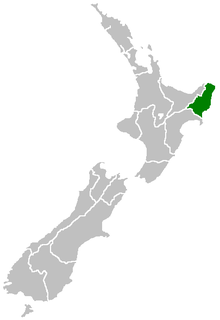
Ruatoria is a town in the Waiapu Valley of the Gisborne Region in the northeastern corner of New Zealand's North Island. The town was originally known as Cross Roads, and was named Ruatorea in 1913, from the Māori Rua-a-Tōrea. In 1925 the name was changed to "Ruatoria", although some texts retain the original spelling.
The Waiapu River is a river in the Gisborne District of the North Island of New Zealand, with a total length of approximately 130 kilometres (81 mi). Found in the north-east of the Waiapu Valley, it flows north-east from the joining of the Mata River and the Tapuaeroa River, then passes by Ruatoria before reaching the Pacific Ocean at Rangitukia. Other tributaries of the Waiapu River include the Mangaoporo, Poroporo, Wairoa, Maraehara rivers, and the Paoaruku stream. It is the most well known river in the region, and lies within the rohe (territory) of Ngāti Porou, the largest iwi on the East Coast, and second largest in New Zealand. The area was the site of hostilities during the New Zealand Wars from June to October in 1865, both between Pākehā and Māori, and between factions of Ngāti Porou.

Gisborne Botanical Gardens is a public garden in Gisborne, New Zealand, that dates back to 1874. The Gisborne Botanical Gardens nowadays occupy 5.1 hectares (0.051 km2) between Aberdeen Road and the Taruheru River. There are still many trees remaining from the early period.

The Gisborne District is an area of northeastern New Zealand governed by the Gisborne District Council. A unitary authority, it is also known as the Gisborne Region. It is named after its largest settlement, the city of Gisborne. The region is also commonly referred to as the East Coast.
Victoria is a suburb of the New Zealand city of Gisborne. It is located close to the shore of Poverty Bay, to the southeast of the city centre, between the mouth of the Awapuni Creek and Awapuni. It was named for Queen Victoria.
Kaiti is a suburb of the New Zealand city of Gisborne. It is located immediately to the east of the city centre, on the opposing bank of the Waimata River. Kaiti Hill or Titirangi overlooks Poverty Bay with Young Nick's Head across the Bay. Titirangi also overlooks the city. The Turanganui River is below it, and separates Kaiti from the Gisborne Central Business District.
Mangapapa is a suburb of the New Zealand city of Gisborne. It is located in the north of the city. Whataupoko lies to the southeast and Te Hapara to the south, separated from Mangapapa by the Taruheru River.
Whataupoko is the central suburb of the New Zealand city of Gisborne. It is located to the northeast of the city business district.
Waiau River is a river in the Gisborne Region of New Zealand. It has its headwaters in the same area of hill country to the east of the Raukumara Range as the Mata River, flowing firstly north, then east to become a tributary of the Hikuwai River.
The Mangahauini River is a river of the Gisborne Region of New Zealand's North Island. It flows generally south from its origins southwest of Te Puia Springs, reaching the Pacific Ocean close to the settlement of Tokomaru Bay.
The Mangaheia River is a river of the Gisborne Region of New Zealand's North Island. It flows southeast from its origins in rough hill country inland from Tolaga Bay, joining with the Uawa River close to its outflow into the bay.
The Mangatokerau River is a river of the Gisborne Region of New Zealand's North Island. It flows generally southeast to meet the Uawa River, which it joins 7 kilometres (4 mi) from the latter's Tolaga Bay mouth.
The Pakarae River is a river of the Gisborne Region of New Zealand's North Island. It flows a convoluted generally southeastern course from its sources 20 kilometres (12 mi) inland from Tolaga Bay, reaching the Pacific Ocean 25 kilometres (16 mi) northeast of Gisborne.
The Pouawa River is a river of the Gisborne Region of New Zealand's North Island. It flows predominantly southeast, reaching the Pacific Ocean 15 kilometres (9 mi) northeast of Gisborne.
The Tapuaeroa River is a river of the Gisborne Region of New Zealand's North Island. It flows southeast from its sources in the Raukumara Range, joining its waters with those of the Mata River close to the town of Ruatoria, the resulting flow becoming the Waiapu River.
The Waimata River is a river of the Gisborne Region of New Zealand's North Island. It flows predominantly south to reach the city of Gisborne. Here it meets the waters of the Taruheru River, and the combined waters flow to the northern end of Poverty Bay as the Turanganui River.
The Waiomoko River is a river of the Gisborne Region of New Zealand's North Island. It flows southeast to reach the Pacific Ocean 22 kilometres (14 mi) northeast of the city of Gisborne.
The Waitahaia River is a river in the Waiapu Valley of the Gisborne Region of New Zealand's North Island. It flows northeast from the southern end of the Raukumara Range to reach the Mata River 20 kilometres (12 mi) west of Te Puia Springs. It is renowned for its brown trout, a European species of fish introduced into New Zealand for fishing in the late 1860s.
The Wharekahika River is a river of the Gisborne Region of New Zealand's North Island. It flows east, its course paralleling the north coast of the Gisborne Region, and reaches the sea at Hicks Bay.

The Turanganui River is a river in the city of Gisborne, New Zealand. Formed by the confluence of the Taruheru River and the Waimata River, it flows through downtown Gisborne to reach the Pacific Ocean at the northern end of Poverty Bay. A memorial to the first landing place in New Zealand by Captain James Cook is located close to the mouth of the river. The entire river is tidal.







